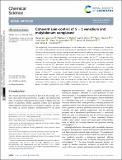| dc.contributor.author | Laorenza, Daniel W | |
| dc.contributor.author | Mullin, Kathleen R | |
| dc.contributor.author | Weiss, Leah R | |
| dc.contributor.author | Bayliss, Sam L | |
| dc.contributor.author | Deb, Pratiti | |
| dc.contributor.author | Awschalom, David D | |
| dc.contributor.author | Rondinelli, James M | |
| dc.contributor.author | Freedman, Danna E | |
| dc.date.accessioned | 2024-11-01T20:30:37Z | |
| dc.date.available | 2024-11-01T20:30:37Z | |
| dc.date.issued | 2024-08-05 | |
| dc.identifier.uri | https://hdl.handle.net/1721.1/157463 | |
| dc.description.abstract | The burgeoning field of quantum sensing hinges on the creation and control of quantum bits. To date, the most well-studied quantum sensors are optically active, paramagnetic defects residing in crystalline hosts. We previously developed analogous optically addressable molecules featuring a ground-state spin-triplet centered on a Cr4+ ion with an optical-spin interface. In this work, we evaluate isovalent V3+ and Mo4+ congeners, which offer unique advantages, such as an intrinsic nuclear spin for V3+ or larger spin–orbit coupling for Mo4+, as optically addressable spin systems. We assess the ground-state spin structure and dynamics for each complex, illustrating that all of these spin-triplet species can be coherently controlled. However, unlike the Cr4+ derivatives, these pseudo-tetrahedral V3+ and Mo4+ complexes exhibit no measurable emission. Coupling absorption spectroscopy with computational predictions, we investigate why these complexes exhibit no detectable photoluminescence. These cumulative results suggest that design of future V3+ complexes should target pseudo-tetrahedral symmetries using bidentate or tridentate ligand scaffolds, ideally with deuterated or fluorinated ligand environments. We also suggest that spin-triplet Mo4+, and by extension W4+, complexes may not be suitable candidate optically addressable qubit systems due to their low energy spin-singlet states. By understanding the failures and successes of these systems, we outline additional design features for optically addressable V- or Mo-based molecules to expand the library of tailor-made quantum sensors. | en_US |
| dc.language.iso | en | |
| dc.publisher | Royal Society of Chemistry | en_US |
| dc.relation.isversionof | 10.1039/d4sc03107e | en_US |
| dc.rights | Creative Commons Attribution | en_US |
| dc.rights.uri | https://creativecommons.org/licenses/by/3.0/ | en_US |
| dc.source | Royal Society of Chemistry | en_US |
| dc.title | Coherent spin-control of S = 1 vanadium and molybdenum complexes | en_US |
| dc.type | Article | en_US |
| dc.identifier.citation | Laorenza, Daniel W, Mullin, Kathleen R, Weiss, Leah R, Bayliss, Sam L, Deb, Pratiti et al. 2024. "Coherent spin-control of S = 1 vanadium and molybdenum complexes." Chemical Science, 15 (34). | |
| dc.contributor.department | Massachusetts Institute of Technology. Department of Chemistry | en_US |
| dc.relation.journal | Chemical Science | en_US |
| dc.eprint.version | Final published version | en_US |
| dc.type.uri | http://purl.org/eprint/type/JournalArticle | en_US |
| eprint.status | http://purl.org/eprint/status/PeerReviewed | en_US |
| dc.date.updated | 2024-11-01T20:15:57Z | |
| dspace.orderedauthors | Laorenza, DW; Mullin, KR; Weiss, LR; Bayliss, SL; Deb, P; Awschalom, DD; Rondinelli, JM; Freedman, DE | en_US |
| dspace.date.submission | 2024-11-01T20:15:59Z | |
| mit.journal.volume | 15 | en_US |
| mit.journal.issue | 34 | en_US |
| mit.license | PUBLISHER_CC | |
| mit.metadata.status | Authority Work and Publication Information Needed | en_US |
